The University of the Self #75
Birdsong and Betterness Part 5
This article is a continuation of part 4, which can be found here.
Read part 6 here.

16th June. 6.46 a.m. Back. Still, mild.
Common Chiffchaff, Common Chaffinch, Common Wood-pigeon, European Robin, Eurasian Blue Tit, Eurasian Skylark, Bank Swallow, House Sparrow, Eurasian Wren, Eurasian Blackbird, Dunnock, Song Thrush, Ring-necked Pheasant, Eurasian Jackdaw, Eurasian Tree Sparrow, Eurasian Oystercatcher, Barn Swallow.
6.56 a.m. Front.
European Starling, Eurasian Magpie, Eurasian Collared Dove, European Greenfinch, Little Ringed Plover, Spotted Flycatcher, Eurasian Linnet, Rose-ringed Parakeet (really? I did think it might not be too far-fetched as there have been many sightings of Parakeets in the North East. I also discovered that someone on the site here has a Cockatiel, so maybe the app was picking up that particular bird), European Goldfinch, Water Rail (looking at the map, it could be possible), Coal Tit, Eurasian Treecreeper, Great Tit, Carrion Crow.
17th June 8.33 – 8.43 a.m.
Eurasian Jackdaw, Common Wood-pigeon, Eurasian Blackbird, Eurasian Wren, European Robin, Great Tit, Song Thrush, Eurasian Blue Tit, Common Chiffchaff, Common Chaffinch, Eurasian Treecreeper, Bank Swallow.
20.52 – 21.22 p.m. Still, mild
Common Chaffinch, Western House Martin, Eurasian Blackbird, Bank Swallow, Eurasian Wren, European Goldfinch, European Robin, Common Ringed Plover, Ring-necked Pheasant, Common Wood-pigeon, Mallard, Eurasian Kestrel, Barn Swallow, Carrion Crow, Eurasian Jackdaw, Eurasian Skylark.
There is a line dividing a section of the page off at the bottom. Because my noticing is getting so much better, I have begun to expand into recording some of the wildflowers I am encountering. I haven’t found and app for free which can help me name plants, so I am doing it the more old-fashioned way, through Internet searching. This is a random-seeming little note, but I wanted to use up some spare space on the page. I go and visit my friend, who has a farm in Stamfordham, and there is an amazing array of wildflowers growing there. I have discovered another hole in my nature knowledge, and in the spirit of learning, I have identified and written down some of them:
Wildflowers at Denise’s
Lady’s Bedstraw, Meadowsweet, Chicory, Speedwell, Self-heal, Tormentil
——————————————————————————————————
On the 20th June, I had a bit of a meltdown. I had one of those dreadful mornings that follow a poor night’s sleep. I was heavy in soul and heart. I made the best start I could on the housework, wishing, as always, that I didn’t find mess so triggering, so impossible to ignore. I got myself in a sadness spiral – some days I find I can accept the constant pain and fatigue better than others. This day, I was upset with myself – upset with my body. I do keep suffering these bouts of grief at the changes, the shrinking boundaries. And yes, I felt guilty afterwards for feeling this. I am lucky to be able to do what I still do – I am lucky to be able to live in safety while I negotiate this altered future.
I do find myself minimising my feelings before someone does it for me. I don’t currently know how to deal with acknowledging my feelings properly while keeping a sense of perspective toward the suffering of others. I am trying to find the right balance. Often, I feel like a whiny, self-pitying, self-absorbed person (hello internalised ableism?). Often I feel as if I don’t have permission (from who? Internal? External?) to express how I feel, physically and mentally against the problems of the world. I did end up telling my husband that I had had enough, that I feel as if I never go anywhere anymore, that there is so much in the world that I will, for myriad reasons, never experience. Then, to my surprise, we went on a little trip.
I love a bit of history, and it’s even better when you can find a bit of it for free. I delivered a workshop a while ago using lead mining in Allendale and Weardale as inspiration. I did a fair amount of very interesting research, so it was so wonderful to find the surprise destination was Langley Smelt Mill Chimney, which is accessible via a flat path about 100 yards from the road. We had driven past this chimney before, but had never stopped and visited. It was a beautiful day - sunny but breezy, just a nice amount of heat.
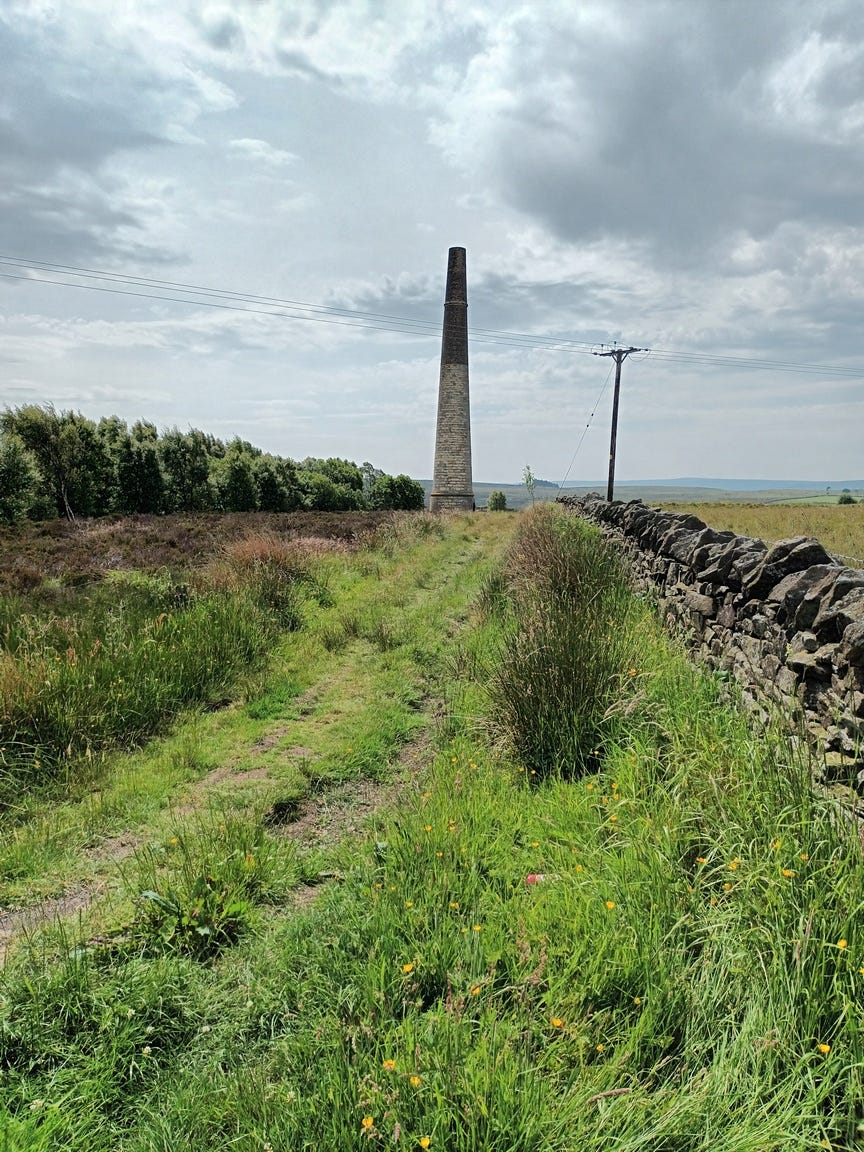
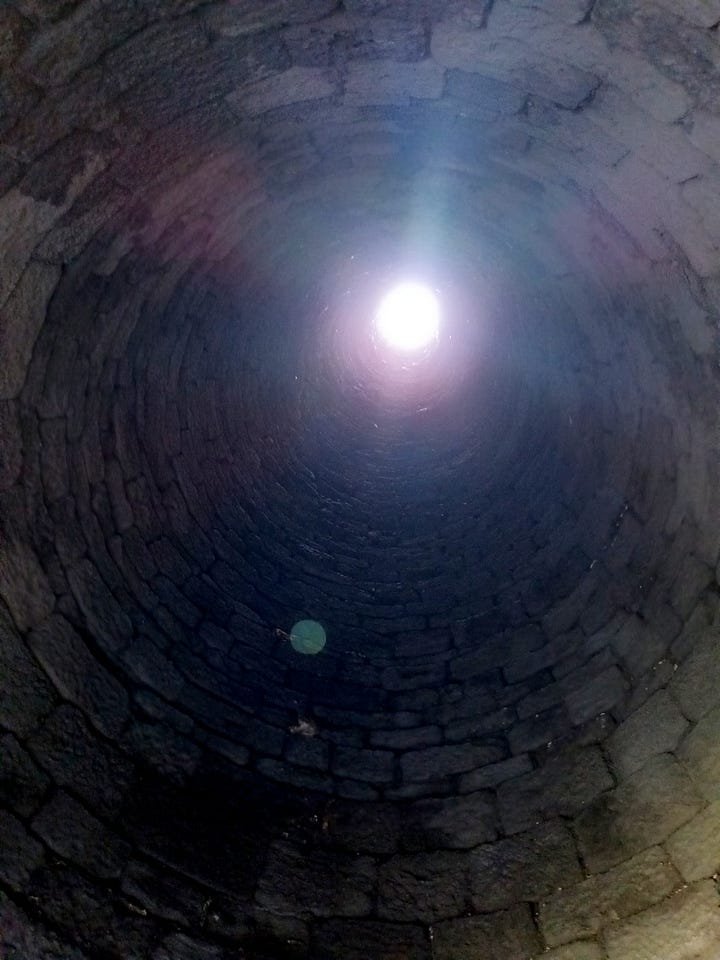
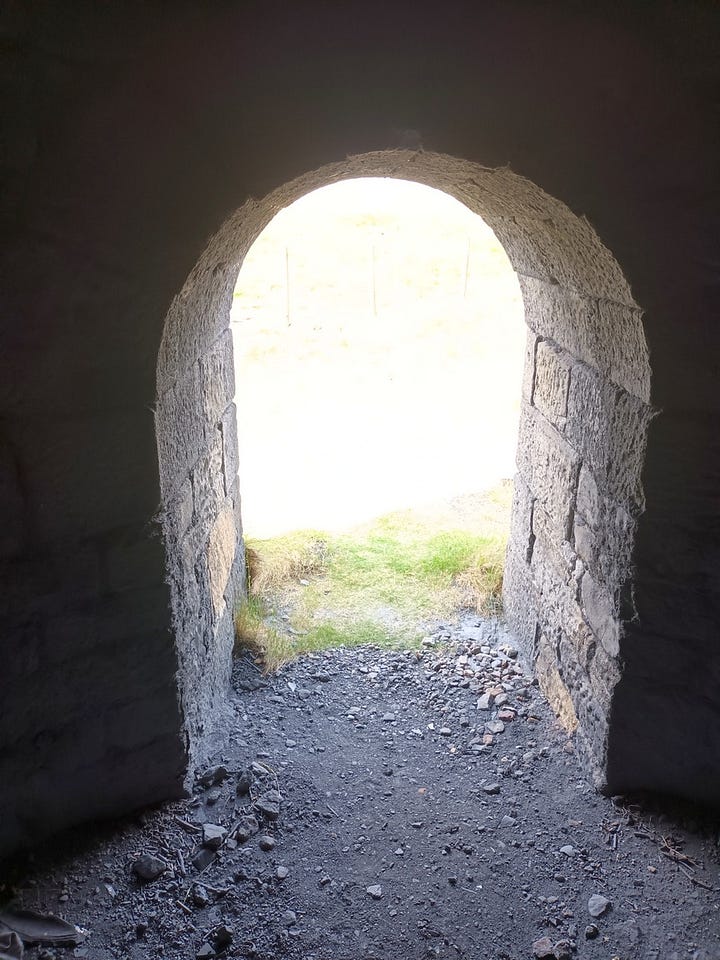
It was wonderful to visit the chimney – a remnant of industry past, a lonely-seeming spire, rising from the fell – a stone ghost, the last vestige of another way of life. I wondered how it felt when storms came. Did it fill with rain? How did the wind sound, passing through it?
There were three nature moments around the chimney which left me elated. The path carried on for a few more yards behind the chimney - perhaps there are further footpaths, but the footing had become precarious due to the lumpy, tussocky ground. I looked around. Growing there were a gorgeous plenitude of common cotton-grass, its fluffy blooms waving from the tough green stalks like a hundred rabbit tails. I was entranced.
They grew around the foot of a solitary tree. I look back on this moment with certain regret – my noticing skills which have become so much more heightened lately, had not developed enough to note the variety of the solitary tree. I was too enraptured by the cotton-grass to think that far ahead, and I am sorry for this now. But that is learning for you. What I regretted then, I can make redress for next time.
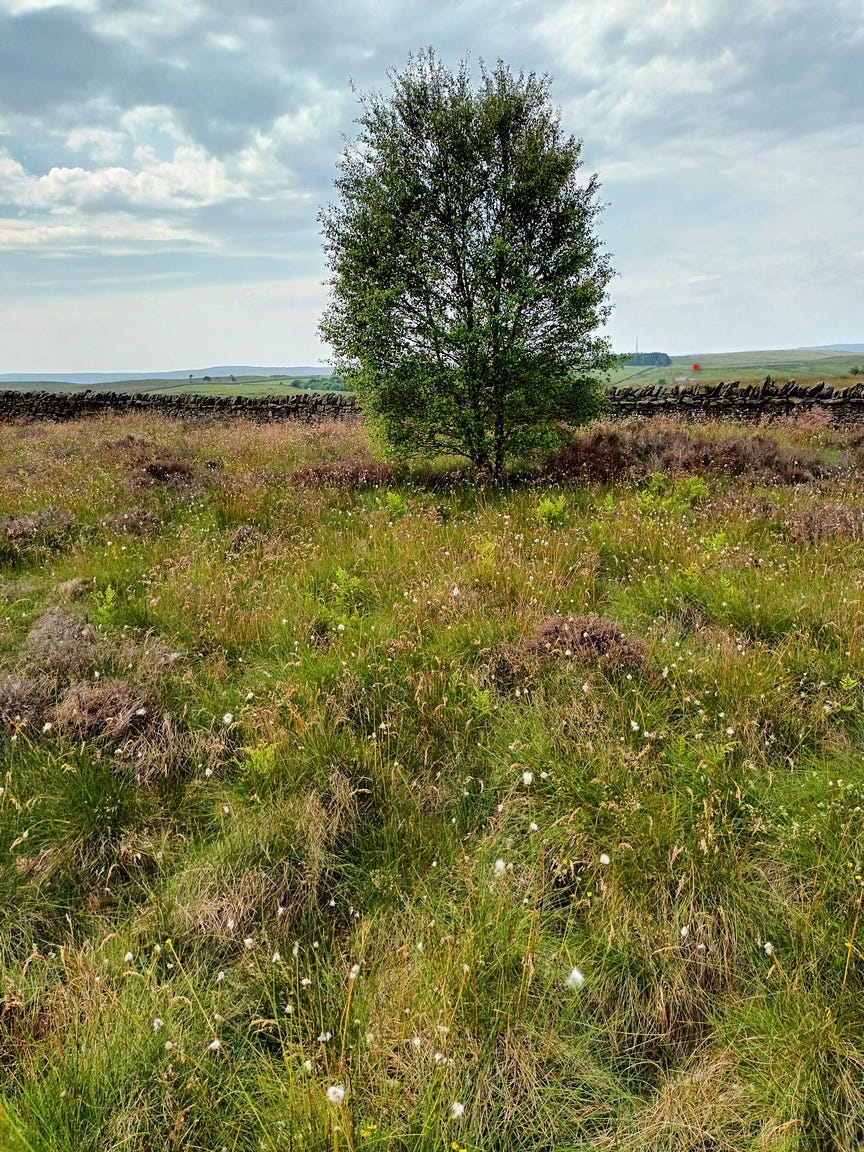
Secondly, was the noticing of an elfin tree. I had written a poem a while ago, as part of an eco-sonnet chain (which can be read here), and research for the poem had led me into a fascination about elfin trees – trees whose growth is reduced by harsher environments. We actually have an elfin apple tree behind our hedge, which has never grown any more in the nine years we have been here, and it was planted years before we came. It is exquisite, just like something from a fairy tale. It is brimming with magic. I found another at this place – an elfin Silver Birch, and I spent some time next to it, sensing some of its own thaumaturgy.
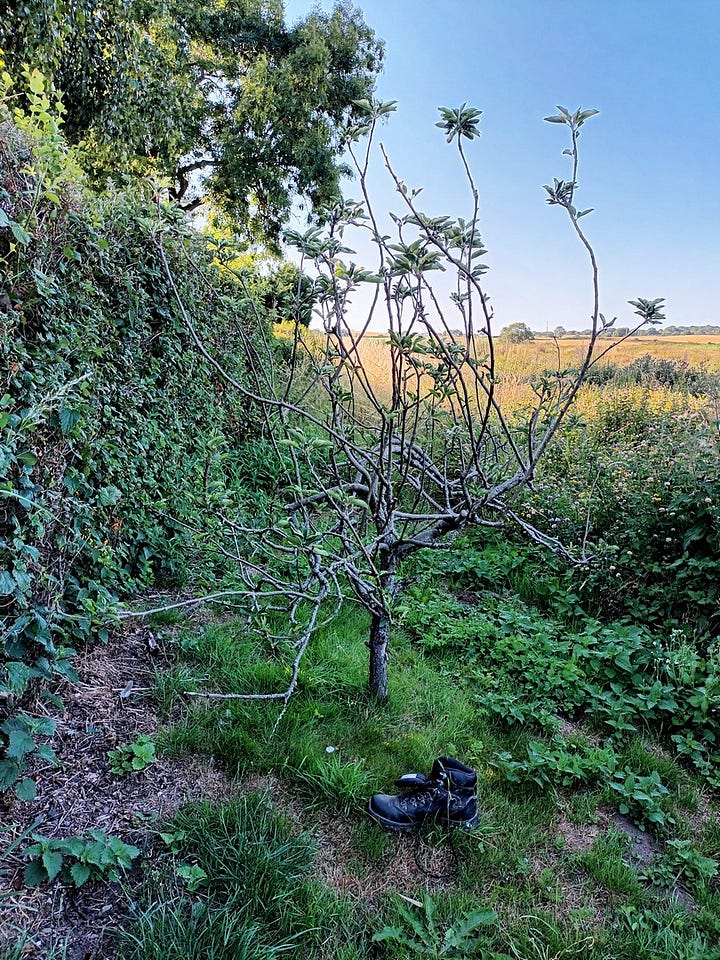

Thirdly, was the multitude of Curlew calls I heard at this location. So many, and all so beautiful. This was a Curlew landscape. How might one describe the Curlew’s voice? Charlotte Varela, in their article ‘Curlews in Literature’, describes how “Sadness, longing, joy – they can all be found in the call of the curlew, and it is this call that lodges deep in the hearts of poets, authors and story tellers.” Yeat’s wrote that their “…crying brings to my mind / passion-dimmed eyes…” Dylan Thomas imagined women who “…yearn with tongues of curlews for the unconceived…” There is no doubt the call of a Curlew pierces the soul – as Ted Huges described them as, “Lancing their voices / Through the skin of this light.”
Yes, the Curlew’s call goes through the soul like an arrow. But it is so much more than our human word ‘mournful’. Hearing it leaves you feeling somehow more alive – sharper, more alert, more connected to the Earth, more otherworldly, and crucially, as an Anglo-Saxon bard wrote, in the poem, ‘The Seafarer’, it can make you feel glad too – so glad you might well prefer it to human noise (and I heartily agree with that):
“Hwilum ylfete song / dyde ic me to gomene, / ganotes hleoþor / ond huilpan sweg / fore hleahtor wera…”
“At times the swan's song / I took to myself as pleasure, / the gannet's noise / and the voice of the curlew / instead of the laughter of men…”
I have found a written description here, courtesy of Charlotte Verela, in the hope that I can make this article as accessible as possible:
“This haunting ‘cur-lee, cur-lee’ is one of the most evocative sounds in the natural world, reaching deep into the heart as if, described the naturalist, W.H. Hudson, “uttered by some filmy being, half spirit and half bird.”
My nascent bird-noticing had led me, prior to this trip out, to a Curlew diptych – here, at our off-grid Northumberland cottage, near the banks of the River Tyne, I sometimes hear Curlews while I am sitting alone on the bench. The sound transports me, frees me for a while from the weight of negativity – lifts another self from my usual body. It tells me that it is okay to cry your loneliness – that it is indeed okay to be lonely. Not every lonesome is bad. Sometimes it is better to be so. There can be a purity in and a balm in detachment, in private moments of withdrawal. This is how you are meant to be, the Curlew tells me – isolate, calm, unburdened, just and only you.
I have also seen and head them at my friend’s Northumberland farm – at the bottom of one of her fields is a boggy area (which is still soft at the moment, but due to the heat, the water has dried), and behind that, a small area of overgrown grasses. Curlews are nesting there. This was my first sighting of them – when my friend and I were checking for ragwort, I heard their distinctive cry, but loud, panicked, urgent.
At first, I was confused – I thought I had mistaken the cry and was witnessing a bird of prey chasing a Carrion Crow. I was not expecting the Curlew to look so large in flight, and I was momentarily shocked (they have a wingspan of 35 – 42 inches) but a Curlew it was, and the Carrion Crow had been attacking its ground-built nest. Research has informed me that yes, Crows will and do attack their nests for the eggs and small chicks. Do we detest the Crow for its act? No. This is survival. I could only stand there and hope that the eggs would survive. It was not my place to interfere - this is nature, and sometimes it can seem cruel, and cruel is a human word.
It did not make it any easier to witness. There I was, overflowing with human heartbreak. But how can we know whether or not the Curlew was feeling the same? Grief does not belong to humans alone. Nor does love.
I have also witnessed them here, at our off-grid Northumberland cottage, near the banks of the River Tyne, I sometimes hear Curlews while I am sitting alone on the bench. The sound transports me, frees me for a while from the weight of negativity – lifts another self from my usual body. It tells me that it is okay to cry your loneliness – that it is indeed okay to be lonely. Not every lonesome is bad. Sometimes it is better to be so. There can be a purity in and a balm in detachment, in private moments of withdrawal. This is how you are meant to be, the Curlew tells me – isolate, calm, unburdened, just and only you.
Now, with the hearing of them at Langley Smelt Mill Chimney, I had a Curlew triptych, and it felt as holy to me as any other pieta. Three places I have been, so have they. Was I wrong to feel hopeful for their population? Was I just another silly fool to think that the Curlew triptych held a wider significance for me? That it meant something? What, I do not yet know. Perhaps I am not meant to know, or perhaps all will be revealed to me in the future, when my studies and noticings have placed me in a better frame of mind to comprehend their message.
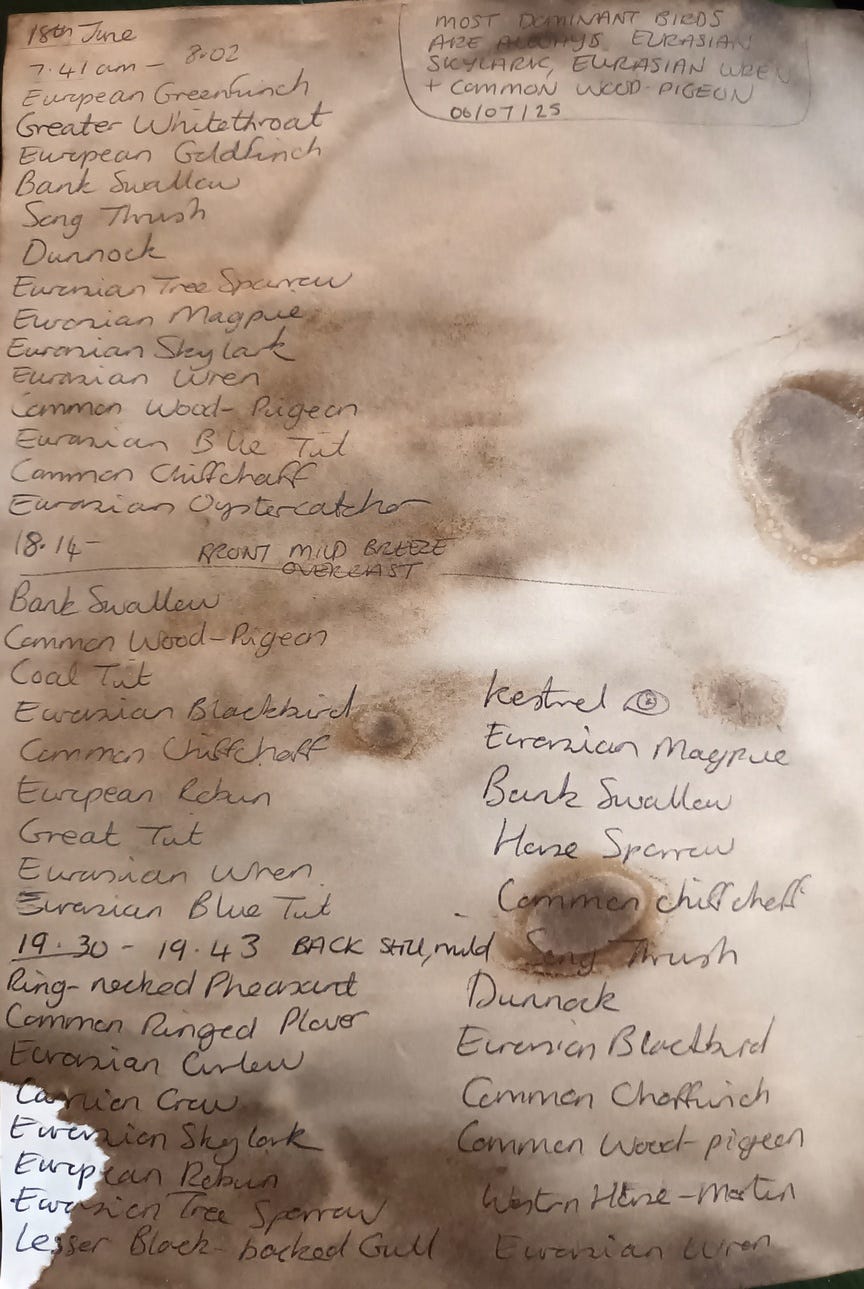
18th June 7.41 – 8.02 a.m.
European Greenfinch, Greater Whitethroat, European Goldfinch, Bank Swallow, Song Thrush, Dunnock, Eurasian Tree Sparrow, Eurasian Skylark, Eurasian Wren, Common Wood-pigeon, Eurasian Blue Tit, Common Chiffchaff, Eurasian Oystercatcher.
18.14 p.m. Front. Mild breeze, overcast
Common Wood-pigeon, Bank Swallow, Coal Tit, Eurasian Blackbird, Common Chiffchaff, European Robin, Great Tit, Eurasian Wren, Eurasian Blue Tit
19.30 – 19.43 p.m. Back. Still, mild
Ring-necked Pheasant, Common Ringed Plover, Eurasian Curlew, Carrion Crow, Eurasian Skylark, European Robin, Eurasian Tree Sparrow, Lesser Black-backed Gull, Eurasian Kestrel, Eurasian Magpie, Bank Swallow, House Sparrow, Common Chiffchaff, Song Thrush, Dunnock, Eurasian Blackbird, Common Chaffinch, Common Wood-pigeon, Western House Martin, Eurasian Wren.
On 6th July, I added a note top right:
Most dominant birds are always Eurasian Skylark, Eurasian Wren & Common Wood-pigeon
—————————————————————————————————————
Please consider helping me to keep on sharing my articles with you…
I hope you enjoyed reading my latest article. Thank you so much for spending some time here with me. Times are tough, but if you feel like supporting a struggling writer so that she can continue being able to write, (every tiny bit helps) you can do so below…
I have currently left my Substack free, but if anyone should feel like sending me a tip (although there is no pressure to do so) in exchange for my tips, you can ‘buy me a coffee’ here . Every little bit makes a big difference. Or please do subscribe, which you can do either as paid or free. Either will let you see my articles. Many thanks.
If you like the article you have read, please do click the like button — I’d love to know you are out there.
I must add the usual disclaimer here: I am not sponsored or paid by any of the websites I link to (I do this in an attempt to help others find information, and I may or may not agree/disagree with any/some of the content) — sharing does not immediately equal endorsment. I also hope I haven’t written anyting that might offend anyone. I try very hard to be as considerate and kind as possible.


Another absorbing post. I enjoyed it very much, waiting till I'd the time and inclination to read it. Your posts aren't to be rushed.
I should add your powers of observation are entrancing. I can do flowers reasonably well (years ago botany training) but bird song and sight so often leave me flumoxed. And I’m taking a leaf ? From your observation practice - the listening. Xx